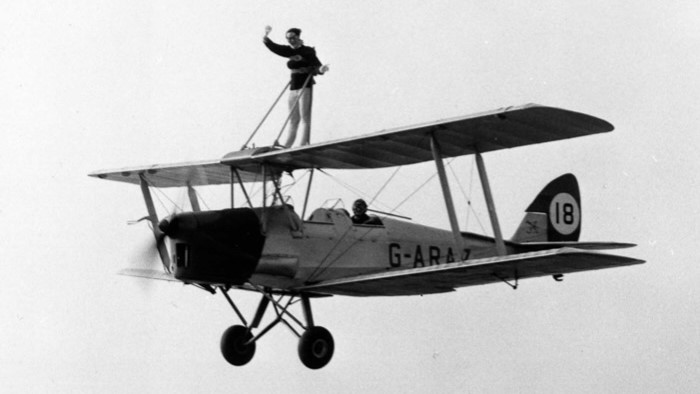The body of Miss Deborah DeCostello, aeronaut, who drowned in Lake Michigan October 1st, was found Saturday by Joe Black on November 6th”, reported the Empire Journal in 1920. Female daredevil Deborah DeCostello, 27, had come to Empire to entertain as part of the county fair. She was to jump from the bi-plane wearing her parachute (which were unheard of then) on the 29th and 30th of September but was unable to because the weather was very bad as it sometimes is in September.
Even though she was offered $400 NOT to jump after the fair had ended, she insisted and jumped the day after the fair was over. Somehow the pilot misjudged the wind and took off going well out over the lake. He must have thought there was an onshore wind and figured Debora would float back toward the town and dry land. Either the wind switched, or he made a bad weather error.
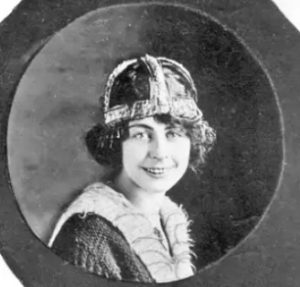
Miss Debora DeCostello, aeronaut, died in Empire after her parachute dropped over Lake Michigan instead of dry land in 1920. This photo is from Ancestry.com which says she lived from 1893-1920 which would make her 27. Another source called her 17 but either way, too young to be walking on the wings of airplanes.
Deborah’s Last Jump
When Deborah jumped out she was well over the lake and never drifted toward shore. Some say the pilot made several attempts to use his prop wash to force her ashore or to try to hook her parachute with his wing. Gertrude Coppens, whose husband was with the Coast Guard said, “They went down to rescue her, and when they got down there, the parachute was still floating, but it went down before they could rescue her”.
She could not cut herself loose. The pilot said it probably got tangled some way, so she went right down with the parachute. But strangely the parachute was not with her when she was found.
Money was raised for her funeral and tombstone by selling a diamond ring found on her body. There was also a dance to help raise the necessary funds, as no family members could be located. On Nov. 8 she was buried in St. Philip’s cemetery in Empire, and there she shall remain.
Where did this dangerous, daredevil stunt come from?
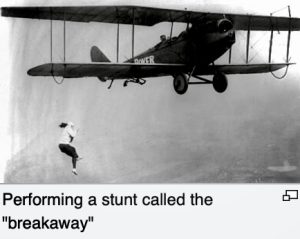
Lillian Boyer in her “breakaway” stunt in which she climbs down a ladder and then hangs upside down from it while the airplane flies on. Courtesy alamy.com
Ever since the first powered flight by Orville Wright in 1903, everyone was racing to be the first in the air. A short decade later the airplane in its many configurations made a sensation at expositions, air races and airfares. In 1918 WWI erupted and this is where wing-walking takes root.
Ormer Locklear
The first wing walker who performed daring stunts was 26 year old Ormer Locklear, who would walk onto the wings of his bi-plane. he did this during pilot training in the Army Air Service during World War I to fix mechanical issues mid-air without having to land. By 1918 he was wowing crowds with his daredevil wing walking stunts. He would later go on to be one of the first daredevils to perform stunts for the public as part of the aerial show movement of the 1920’s. Unfortunately, he would also eventually meet his end during a wing-walking stunt.
Aviation in the 20’s
The 1920’s were a transitional period in American aviation history, a time of almost unstructured activity. This was before the beginnings of regulations and the dawn of commercial aviation in the last half of the 1920’s. There were no laws or licenses. You were not required to have any qualifications to fly a plane or carry passengers.
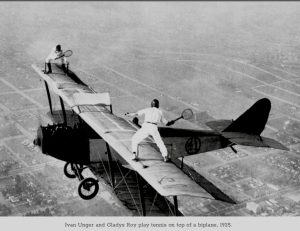
Gladys Roy playing tennis while wing walking. She famously once said, “Of late the crowds are beginning to tire of even my most difficult stunts and so I must necessarily invent new ones if I want to hold my reputation as a daredevil. Google Image
The 1920s were also carefree years when flappers danced the Charleston, speakeasies offered illegal booze and bootlegging was said to be happening even in Omena. Women were discovering new freedom, champagne flowed freely, and everyone lived like they were immortal.
Deborah jumped from airplanes at fairs, and may be the first female to do such a daring thing in 1920, but others soon followed.
Gladys Roy
Another early wing walker was Gladys Roy, born around the turn of the century. She started in 1921 as a parachute jumper like Deborah DeCostello, and later became a wing walker. She was famous for conducting a variety of stunts on the upper wings of a flying bi-plane including playing tennis, walking blindfolded across wings, and dancing the Charleston. “Of late”, she told the Los Angeles Times in 1926, “the crowds are beginning to tire of even my most difficult stunts and so I must necessarily invent new ones if I want to hold my reputation as a daredevil. Eventually an accident will occur….”
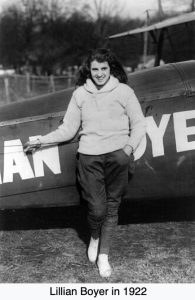
Lillian Boyer, the waitress who was invited by a customer to go for her first airplane ride. On her second ride she climbed out on the wing thus beginning her career in 1921 as an aerial performer. She retired safely in 1929. Courtesy Wikipedia
She died the following year, not in the air, but while posing for pictures in front of an airplane and accidentally backing into a spinning propeller.
For most wing walkers the experience could be terrifying. It was tempting just to freeze up and hold on. If you were going to move, you had to be careful to make sure you’re holding something substantial enough to take your weight in the face of winds blowing nearly 100 miles per hour. The first rule of wing walking, according to historians, is “don’t let go of what you’ve got until you get ahold of something better.”
Lillian Boyer
One of the last wing walkers was a restaurant waitress named Lillian Boyer who was eager to fly in an airplane. She was invited by two restaurant customers to take an airplane ride. On her second ride she climbed out on the wing thus beginning her career in 1921 as an aerial performer. She performed many daring stunts and achieved great public acclaim.
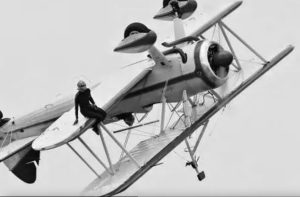
Jane Wicker, who said “nothing feels more exhilarating than the wind and sky rushing by as the earth rolls around my head.” Her plane crashed while doing this stunt, killing both her and the pilot. Courtesy nypost.com
In 1929 when, after 37 parachute jumps, 143 automobile to plane changes, and 352 air shows, most of them wing-walking, federal regulations on low flying and unsafe planes forced her and many other barnstormers into retirement.
Jane Wicker
Jane Wicker, a wing walker who died in a fiery crash while preforming in 2013, was asked shortly before she died why she would take such chances. She said “There is nothing that feels more exhilarating or freer to me than the wind and sky rushing by me as the earth rolls around my head. I am alive up there. To soar like a bird and touch the sky puts me in a place where I feel I totally belong.”

